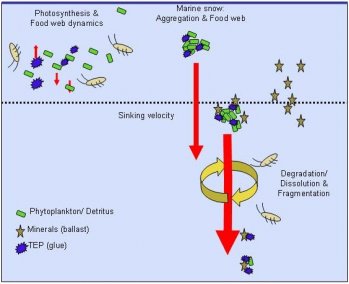Project: Will Ocean Acidification Diminish Particle Aggregation and Mineral Scavenging, Thus Weakening the Biological Pump?
Description
Will Ocean Acidification Diminish Particle Aggregation and Mineral Scavenging, Thus Weakening the Biological Pump?
This award is funded under the American Recovery and Reinvestment Act of 2009 (Public Law 111-5).
The pH of the ocean is predicted to decrease by 0.2-0.5 pH units in the next 50 to100 years as a result of increasing atmospheric CO2. To date almost all the research on impending ocean acidification has focused on the impacts to calcifying organisms and the carbonate system. However, ocean acidification will also affect other significant marine processes that are pH dependent.
In this project, researchers at the University of California at Santa Barbara will investigate the impact of ocean acidification on the organic carbon or 'soft tissue' biological pump. They predict that a decline in oceanic pH will result in an increase in the protonation of negatively charged substances, especially of Transparent Exopolymer Particles (TEP), the gel-like particles that provide the matrix of aggregates and bind particles together. A decreased polarity of these highly surface-active particles may reduce their "stickiness" resulting in decreased aggregation of organic-rich particles and a decreased ability of aggregates to scavenge and retain heavy ballast minerals. A reduction in aggregation will lower the fraction of POC enclosed in fast-sinking aggregates. Decreased scavenging of minerals by aggregates will result in reduced sinking velocities and consequently a decline in the fraction of material escaping degradation in the water column. Both processes ultimately reduce carbon flux to depth. The resulting weakening of the biological pump will alter pelagic ecology and potentially produce a positive feed-back pathway that further increases atmospheric CO2 concentrations.
The research team will experimentally investigate TEP-production, aggregation rates and aggregate characteristics, mineral scavenging and sinking velocity as a function of ocean acidification, because these parameters are susceptible to pH and central in determining sedimentation rate of organic carbon. They will determine potential changes in the abiotic formation of TEP or in the release rate of TEP or TEP-precursors by phytoplankton that have been adapted to increased CO2 regimes for multiple generations, up to 1000 doublings. Additionally, they will experimentally test potential changes in the aggregation rate of adapted phytoplankton and natural particles, and measure impacts on scavenging rates of ballast minerals by aggregates. Effects of various acidification levels on aggregate characteristics, including size, composition, density, and sinking velocity will also be determined. These results are expected to provide parameterization for a predictive model that will be used to investigate the impact of changing ballasting or aggregation on carbon flux.
Broader impact: Climate and environmental change are a global challenge to society. We need to know if possible positive feed back mechanisms to the biological pump will further increase atmospheric CO2 in order to prepare for and hopefully manage future climate changes.
These data are also available at Pangea
RELATED FILES:
Passow U (2012) The Abiotic Formation of Tep under Ocean Acidification Scenarios. Marine Chemistry 128-129:72-80
PUBLICATIONS PRODUCED AS A RESULT OF THIS RESEARCH
Bathmann U, Passow U. "Global Erwaermung. Kohlenstoffpumpen im Ozean steuern das Klima.," Biologie in unserer Zeit 5, v.5, 2010.
Benner I, Passow U. "Utilization of organic nutrients by coccolithophores," Marine Ecology Progress Series, v.404, 2010, p. 21.
Feng Y, Hare C, Leblanc K, Rose J, Zhang Y, DiTullio G, Lee P, Wilhelm S, Rowe J, Sun J, Nemcek N, Gueguen C, Passow U, Benner I, Brown C, Hutchins D. "Effects of increased pCO2 and temperature on the North Atlantic spring bloom. I. The phytoplankton community and biogeochemical response," Marine Ecology Progress Series, v.388, 2009, p. 13.
Gaerdes A, Iversen MH, Grossart H-P, Passow U, Ullrich M. "Diatom associated bacteria are required for aggregation of Thalassiosira weissflogii.," ISME Journal, 2010, p. 1.
Leblanc K, Hare CE, Feng Y, Berg GM, DiTullio GR, Neeley A, Benner I, Sprengel C, Beck A, Sanudo-Wilhelmy SA, Passow U, Klinck K, Rowe JM, Wilhelm SW, Brown CW, Hutchins DA. "Distribution of calcifying and silicifying phytoplankton in relation to environmental and biogeochemical parameters during the late stages of the 2005 North East Atlantic Spring Bloom," Biogeosciences, v.6, 2009, p. 2155.
Ploug H, Terbruggen A, Kaufmann A, Wolf-Gladrow D, Passow U. "A novel method to measure particle sinking velocity in vitro, and its comparison to three other in vitro methods.," Limnolgy and Oceanography Methods, v.8, 2010, p. 386.
Passow, U., Rocha, C.L.D.L., Fairfield, C., Schmidt, K., 2014. Aggregation as a function of pCO2 and mineral particles. Limnology and Oceanography 59 (2), 532-547.
De La Rocha, C.L., Passow, U., 2014. The biological pump. In: Turekian, K.K., Holland, H.D. (Eds.), Treatise on Geochemistry. Elsevier, Oxford, pp. 93-122.
Boyd, P., Rynearson, T., Armstrong, E., Fu, F., Hayashi, K., Hu, Z., Hutchins, D., Kudela, R., Litchman, E., Mulholland, M., Passow, U., Strzepek, R., Whittaker, K., Yu, E., Thomas, M., 2013. Marine Phytoplankton Temperature versus Growth Responses from Polar to Tropical Waters - Outcome of a Scientific Community-Wide Study. PLoS ONE 8 (5), e63091.
Passow, U., Carlson, C., 2012. The Biological Pump in a High CO2 World. Marine Ecology Progress Series 470, 249-271.

People
Principal Investigator: Uta Passow
University of California-Santa Barbara (UCSB-MSI)
Co-Principal Investigator: Dr Alice L. Alldredge
University of California-Santa Barbara (UCSB-MSI)
Contact: Uta Passow
University of California-Santa Barbara (UCSB-MSI)
Programs
Ocean Carbon and Biogeochemistry [OCB]
